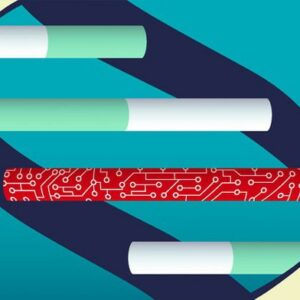
Mark Bathe
PRINCIPAL INVESTIGATOR
Professor, Department of Biological EngineeringAssociate Member, Broad Institute of MIT & HarvardCo-Director, New Engineering Education Transformation
http://bathebionano.org/bathe-bionanolab-team/
Research
STRUCTURAL DNA & RNA NANOTECHNOLOGY
 Natural DNA and RNA are present in all cells as the carriers of genetic information that is passed down through generations. In this work, we are using these nucleic acids as building materials at the nanometer-scale (nanoscale), which is 10,000x smaller than the thickness of a single human hair. We create complex 2D and 3D organized materials using nucleic acids, which we are applying to a broad range of revolutionary applications including: (1) mimicking viruses for vaccines and the targeted delivery of therapeutics such as CRISPR, messenger RNA, and siRNA; (2) organizing chromophores or dyes to mimic light-harvesting complexes to control quantum information for quantum sensing and computing; and (3) organizing high density light-emitting molecules for massive, exabyte-scale molecular data storage, retrieval, and computing. The overall size of the icosahedral structured DNA nanoparticle shown is approximately 40 nanometers, whereas the diameter of the duplex of DNA shown composing each edge of the nanoparticle is 2 nanometers, and the thickness of a human hair is approximately 10,000 to 100,000 nanometers.
Natural DNA and RNA are present in all cells as the carriers of genetic information that is passed down through generations. In this work, we are using these nucleic acids as building materials at the nanometer-scale (nanoscale), which is 10,000x smaller than the thickness of a single human hair. We create complex 2D and 3D organized materials using nucleic acids, which we are applying to a broad range of revolutionary applications including: (1) mimicking viruses for vaccines and the targeted delivery of therapeutics such as CRISPR, messenger RNA, and siRNA; (2) organizing chromophores or dyes to mimic light-harvesting complexes to control quantum information for quantum sensing and computing; and (3) organizing high density light-emitting molecules for massive, exabyte-scale molecular data storage, retrieval, and computing. The overall size of the icosahedral structured DNA nanoparticle shown is approximately 40 nanometers, whereas the diameter of the duplex of DNA shown composing each edge of the nanoparticle is 2 nanometers, and the thickness of a human hair is approximately 10,000 to 100,000 nanometers.
MOLECULAR COMPUTING, DATA STORAGE & RETRIEVAL
 The 4-letter ATGC code of DNA in our cells encodes approximately 1 gigabyte of information per human genome, packaged up neatly within the nucleus of the cell. Synthetic DNA can similarly be used as a storage medium to contain files and other data in an extremely compact manner such that the entire world’s information could in principle fit in the palm of our hand if encoded in DNA. However, retrieving information or files from such “pools” of data encoded in DNA is a highly non-trivial task, since this information is in principle unstructured and disorganized. An analogy would be finding a page or chapter from a book in the US Library of Congress if all of its books were simply piled into the center of a football stadium. In this research area our lab is using DNA nanoparticles to organize and structure data and information stored in DNA, and developing ways to both randomly access arbitrary pools of data ranging from 1 MB to 1 GB from a pool of 1 Exabyte of data (1 Exabyte is 1 billion GB), as well as to compute using these molecular datasets, ranging from machine learning to data sorting and image recognition. Figure from Scientific American.
The 4-letter ATGC code of DNA in our cells encodes approximately 1 gigabyte of information per human genome, packaged up neatly within the nucleus of the cell. Synthetic DNA can similarly be used as a storage medium to contain files and other data in an extremely compact manner such that the entire world’s information could in principle fit in the palm of our hand if encoded in DNA. However, retrieving information or files from such “pools” of data encoded in DNA is a highly non-trivial task, since this information is in principle unstructured and disorganized. An analogy would be finding a page or chapter from a book in the US Library of Congress if all of its books were simply piled into the center of a football stadium. In this research area our lab is using DNA nanoparticles to organize and structure data and information stored in DNA, and developing ways to both randomly access arbitrary pools of data ranging from 1 MB to 1 GB from a pool of 1 Exabyte of data (1 Exabyte is 1 billion GB), as well as to compute using these molecular datasets, ranging from machine learning to data sorting and image recognition. Figure from Scientific American.
COORDINATION OF RNAS FOR STRUCTURAL AND ENZYMATIC STUDIES
RNAs perform a variety of important roles in cells, from acting as trans regulators (e.g. siRNA and lncRNA) of many cellular processes to catalyzing peptide bond formation in the ribosome, and carry the genetic information of retroviruses like HIV and Ebola. The structures of these RNAs play a critical role in their functions, and larger RN As typically move through an ensemble of structural states to function. We are using nucleic acid origami to coordinate RNA structures for two branches of study: (1) to stabilize large RNAs in a single conformation at a time, enabling cryo-EM imaging and reconstruction of what otherwise would be highly noisy structures; and (2) to determine which components of ribonucleoprotein complexes like the ribosome are catalytic and work towards assembling protein-free or minimal-protein enzymes.
As typically move through an ensemble of structural states to function. We are using nucleic acid origami to coordinate RNA structures for two branches of study: (1) to stabilize large RNAs in a single conformation at a time, enabling cryo-EM imaging and reconstruction of what otherwise would be highly noisy structures; and (2) to determine which components of ribonucleoprotein complexes like the ribosome are catalytic and work towards assembling protein-free or minimal-protein enzymes.






